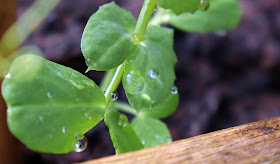A blog about dinghy cruising a Welsford 'Navigator' around the coastal waters of SW England
Tuesday, 31 March 2020
Monday, 30 March 2020
Flushing out a small four stroke Tohatsu 3.5hp outboard engine
When I was testing the outboard the other day in the big black bin outside, something went wrong. The steady stream from the outlet hose suddenly dried up to mere drips. Something, somewhere, had got blocked.
So, an excuse for using the new maintenance stand out in the sunshine on the back decking.
There are one or two points about the stand which in hindsight I wish I could alter. Firstly, putting in that third piece across the top was a mistake - it put the base of the outboard shaft quite high up. If you have a big bin bucket then it isn't a problem - but I was using a plastic trug and this had to rest on top of two breeze blocks to get sufficient depth of water in it and the shaft suitably immersed.
Secondly, why the angle of 8 degree slope to the upright? I don't get why it is needed? In fact I had to alter the trim of the shaft so that the outboard entered the trug vertically. The outboard kept cutting out, like it does occasionally if you are in choppy seas and the transom keeps lifting in and out of the water sometimes whilst you are slowly motoring. Arwen's transom is vertical so I need to remember to readjust it back to that after working on it!
Anyway, the reason for the test was that the water inlet seemed blocked. I was trying out the outboard in its normal big black bin out back when all of a sudden that steady stream of water from the outlet hose suddenly weakened to periodic drips. Normally I'd dash it off to the outboard service engineer who would charge me an arm and a leg, but, as you are all aware, we are not in normal times. So, nothing but to resolve the situation myself.
Firstly I poked a piece of wire up the outlet pipe just to make sure it wasn't blocked there. Nope was't that.
Next, I checked in the manual and decided that it was time to learn how to flush out the engine. Normally I just run it in a bin of freshwater when I get home from a trip. I have never attached the flush piece to the underside before.
So, a piece of hose cut from the garden hose (its OK, her-indoors will never notice the decreasing length - gardening is my thing). A boiling kettle poured over its end and the softened hose soon pushed over the brass inlet piece, before being cooled rapidly under the cold tap. Tight on! Perfect.
A 13 mm spanner loosened the water intake nut and with gentle persuasion it slowly unwound and the inlet piece was inserted. At this point the manual said take the prop off if flushing out the engine - I have no idea why - I just follow the instructions - perhaps its a danger health and safety thing. Split pin crimped and pulled, prop eased off and shear pin inspected for wear. It seemed fine, not surprisingly, as the outboard was serviced last year and I've barely run it for more than 6 hrs since.
With cowling off and the water running, the engine was started in neutral and left to run for several minutes. Three minutes in, the occasional drips from the outlet pipe become a normal streaming torrent as it should be.
SUCCESS!
Oh the SWEET, SWEET smell of SUCCESS! The long dormant engineering genes from my father have finally kicked in! Yes! Result. The first time I have ever managed to successfully repair anything mechanical.
The shear pin slotted in and the prop was put back on. The engine was started up. The outflow stream was strong and steady. The engine idled fine (after I adjusted the 'verticality' of the shaft into the trug).
Yes, I know it is only a minor, minor, engineering procedure......but it is my first minor, minor engineering triumph....so I will enjoy it for now!
So, an excuse for using the new maintenance stand out in the sunshine on the back decking.
There are one or two points about the stand which in hindsight I wish I could alter. Firstly, putting in that third piece across the top was a mistake - it put the base of the outboard shaft quite high up. If you have a big bin bucket then it isn't a problem - but I was using a plastic trug and this had to rest on top of two breeze blocks to get sufficient depth of water in it and the shaft suitably immersed.
Secondly, why the angle of 8 degree slope to the upright? I don't get why it is needed? In fact I had to alter the trim of the shaft so that the outboard entered the trug vertically. The outboard kept cutting out, like it does occasionally if you are in choppy seas and the transom keeps lifting in and out of the water sometimes whilst you are slowly motoring. Arwen's transom is vertical so I need to remember to readjust it back to that after working on it!
Anyway, the reason for the test was that the water inlet seemed blocked. I was trying out the outboard in its normal big black bin out back when all of a sudden that steady stream of water from the outlet hose suddenly weakened to periodic drips. Normally I'd dash it off to the outboard service engineer who would charge me an arm and a leg, but, as you are all aware, we are not in normal times. So, nothing but to resolve the situation myself.
Firstly I poked a piece of wire up the outlet pipe just to make sure it wasn't blocked there. Nope was't that.
Next, I checked in the manual and decided that it was time to learn how to flush out the engine. Normally I just run it in a bin of freshwater when I get home from a trip. I have never attached the flush piece to the underside before.
So, a piece of hose cut from the garden hose (its OK, her-indoors will never notice the decreasing length - gardening is my thing). A boiling kettle poured over its end and the softened hose soon pushed over the brass inlet piece, before being cooled rapidly under the cold tap. Tight on! Perfect.
A 13 mm spanner loosened the water intake nut and with gentle persuasion it slowly unwound and the inlet piece was inserted. At this point the manual said take the prop off if flushing out the engine - I have no idea why - I just follow the instructions - perhaps its a danger health and safety thing. Split pin crimped and pulled, prop eased off and shear pin inspected for wear. It seemed fine, not surprisingly, as the outboard was serviced last year and I've barely run it for more than 6 hrs since.
The water flushing nut was tight and took some persuasion to get it loose!
The prop is looking OK - no obvious chips - some scuffing though
The bits of green weed wrapped tightly around the shaft were loosened and unpicked
New shear and split pin ready to insert
Below the old pin
With cowling off and the water running, the engine was started in neutral and left to run for several minutes. Three minutes in, the occasional drips from the outlet pipe become a normal streaming torrent as it should be.
Next, I took the opportunity to fix the rubber gasket around the cowling edge. It had been coming apart and no longer sat correctly. Some duct tape and a bit of 'stretchy' force and hey presto, the gasket fits back in its grove, forming a proper seal when the cowling hood is put back on the outboard. I'm not convinced it will last though - the cowling looks ever so slightly warped.
SUCCESS!
Oh the SWEET, SWEET smell of SUCCESS! The long dormant engineering genes from my father have finally kicked in! Yes! Result. The first time I have ever managed to successfully repair anything mechanical.
The shear pin slotted in and the prop was put back on. The engine was started up. The outflow stream was strong and steady. The engine idled fine (after I adjusted the 'verticality' of the shaft into the trug).
I have no idea whether the prop shaft should be greased or not - I went with 'greased' - too late now!
Yes, I know it is only a minor, minor, engineering procedure......but it is my first minor, minor engineering triumph....so I will enjoy it for now!




























































